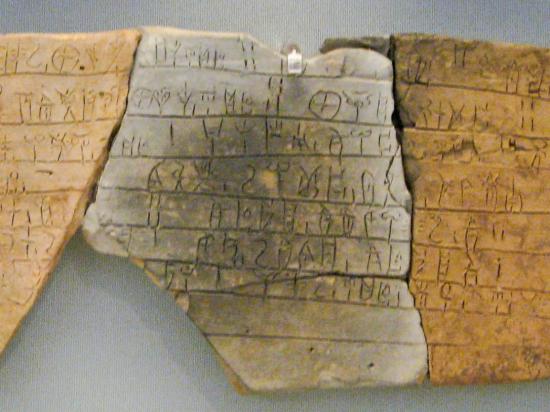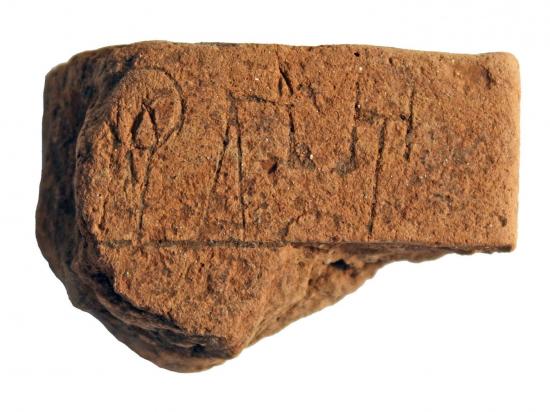PART.2
Cosmopoulos' conclusion is bolstered by the earlier discovery of the tablet containing a bureaucratic record, written in Linear B.
 Clay tablet inscribed with Linear B, from the Palace of Nestor in Pylos. It contains information on the distribution of bovine, pig and deer hides to shoe and saddle-makers. Sharon Mollerus, Wikimedia Commons
Clay tablet inscribed with Linear B, from the Palace of Nestor in Pylos. It contains information on the distribution of bovine, pig and deer hides to shoe and saddle-makers. Sharon Mollerus, Wikimedia Commons
Linear B is a form of writing thought to have descended from an older, still undeciphered writing system known as Linear A, that was used on the island of Crete. Archeologists think Linear A is related to the yet older hieroglyph system used by the ancient Egyptians.

Iklaina tablet, with government record, written in Linear B Michael Cosmopoulous
“The tablet has inscriptions on both sides, on one side a list of male names with numbers (possibly a personnel list), and on the other a list of products - only the heading is preserved, which reads 'manufactured' or 'assembled'. But the tablet is broken and the actual list is missing,” Cosmopoulos said.
The discovery makes it the earliest-known government record in Europe, he says, adding: "But until the final study, we don't know whether it dates to the period when Iklaina was an independent capital.”
The humiliation of Iklaina
Mainland Greece in the Late Bronze Age (ca. 1600-1100 B.C.E.) was divided into independent kingdoms, connected in some kind of loose association, which developed into complex states. All were Mycenaean Greeks and they shared common cultural elements, including architectural types, pottery, religious beliefs, and language, written in Linear B. Iklaina turns out to have been an early example of such a state.
“It appears that the formation of those states was the product of military conflict between powerful rulers. As some rulers became more powerful than others, they started to annex the territories of their neighbors, creating larger and more complex states,” Michael Cosmopoulos told Haaretz.
In any case, after the town's destruction apparently by the Palace of Nestor, Iklaina was downgraded into an industrial center. Evidence of agricultural produce such as wheat and barley, stock raising of pigs, sheep and goats as well as metallurgy and, possibly, linen production have all been found on site.
 Aeriel view of Iklaina: This was no backwater but the center of an early complex state. Michael Cosmopoulous
Aeriel view of Iklaina: This was no backwater but the center of an early complex state. Michael Cosmopoulous
Illiterate in Israel?
As for Iklaina's Linear B tablet, which precedes all others in the region, its discovery has led scholars to revise the assumption that writing was limited to the elite and to the major ruling centers of the time.
Literacy – and mainly, bureaucracy – evidently appeared earlier, and were more widespread across Greece, than had been assumed until now.
It bears mention that other writing systems elsewhere are much older. For example, writings found in China, Mesopotamia, and Egypt are thought to date as far back as 3,000 B.C.E. – over 5,000 years ago. But writing had not been considered widespread in ancient Greece in the 14th century B.C.E. The existence of the tablet, containing government information, not, say, sacred texts legible only to high priests, begs the thought that literacy was not uncommon at the time.
If literacy was, after all, widespread in Greece in the 14th century B.C.E. and there is evidence of writing from Mesopotamia and Egypt from the 3rd millennium B.C.E, one might ask: Why did Israel and Judah remain illiterate?
One who thinks they didn't is Allan Millard, professor of Hebrew and ancient Semitic languages at Liverpool University. He even contends that some parts of the Bible could date as far back as the 13th century B.C.E., and that writing was widespread across the kingdoms of Israel and Judah in the 8th and 7th centuries B.C.E.
“There are scores of brief notes, messages and lists written on potsherds, the ancient scrap paper, from the 8th to early 6th centuries B.C.E. There are a few pieces of writing that may be Hebrew from the 10th and 9th centuries, but the script does not yet have clearly Hebrew features and the texts are too short to be certainly Hebrew. They, along with others, show scribal activity in those centuries,” he told Haaretz.
 The oldest Hebrew writing found to date, discovered at Khirbet Qeiyafa, the fortress city overlooking a valley where the bible says David slew Goliath. Ronen Zvulun, Reuters
The oldest Hebrew writing found to date, discovered at Khirbet Qeiyafa, the fortress city overlooking a valley where the bible says David slew Goliath. Ronen Zvulun, Reuters
The sheer number of sites, the quantity of ephemeral texts and the multitude of seals and impressions bearing owners’ names should dispel any notion that writing was rare in early Israel and Judah, Millard argues. And if scribes were employed for legal and administrative duties such as making lists, setting out legal deals and writing letters, it is reasonable to expect some to have spent time writing other texts, as in Mesopotamia and Egypt.